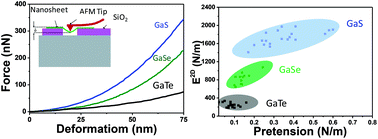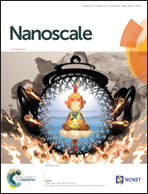Elastic properties and breaking strengths of GaS, GaSe and GaTe nanosheets
Abstract
Gallium sulphide (GaS), gallium selenide (GaSe), and gallium telluride (GaTe), belonging to the group-III monochalcogenide family, have shown promising optoelectronic performance over graphene and monolayer molybdenum disulphide (MoS2). However, to date, the mechanical properties of these materials have not been investigated, which hinders their utilisation in flexible electronics and optomechanics. Here, we characterize the elastic properties and breaking strengths of suspended two-dimensional (2D) nanosheets of GaS, GaSe, and GaTe, using atomic force microscopy. The 2D Young's modulus values of ∼10 nm thick GaS, GaSe, and GaTe were found to be 1732 ± 154 N m−1, 819 ± 127 N m−1, and 246 ± 160 N m−1, respectively, corresponding to the three-dimensional (3D) Young's modulus values of 173 ± 15 GPa, 81.9 ± 12.7 GPa, and 24.6 ± 16 GPa, respectively. The pre-tension values of these nanosheets were estimated to be 0.34 ± 0.12 N m−1, 0.14 ± 0.04 N m−1, and 0.15 ± 0.03 N m−1 for GaS, GaSe, and GaTe, respectively. GaS nanosheets exhibited the highest Young's modulus (173 GPa) among these nanosheets, which is comparable to that of WS2 and WSe2. A failure characteristic study over these group-III monochalcogenides revealed that these materials can withstand stresses of up to 8 GPa and a maximal strain of 7% before breaking. Altogether, our findings indicate that GaS, GaSe, and GaTe are attractive candidates for use in stretchable electronic applications and in future optomechanical devices.



 Please wait while we load your content...
Please wait while we load your content...